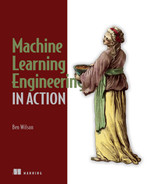Field-tested tips, tricks, and design patterns for building machine learning projects that are deployable, maintainable, and secure from concept to production.
In Machine Learning Engineering in Action, you will learn:
Ferrying a machine learning project from your data science team to your end users is no easy task. Machine Learning Engineering in Action will help you make it simple. Inside, you’ll find fantastic advice from veteran industry expert Ben Wilson, Principal Resident Solutions Architect at Databricks.
Ben introduces his personal toolbox of techniques for building deployable and maintainable production machine learning systems. You’ll learn the importance of Agile methodologies for fast prototyping and conferring with stakeholders, while developing a new appreciation for the importance of planning. Adopting well-established software development standards will help you deliver better code management, and make it easier to test, scale, and even reuse your machine learning code. Every method is explained in a friendly, peer-to-peer style and illustrated with production-ready source code.
About the Technology
Deliver maximum performance from your models and data. This collection of reproducible techniques will help you build stable data pipelines, efficient application workflows, and maintainable models every time. Based on decades of good software engineering practice, machine learning engineering ensures your ML systems are resilient, adaptable, and perform in production.
About the Book
Machine Learning Engineering in Action teaches you core principles and practices for designing, building, and delivering successful machine learning projects. You’ll discover software engineering techniques like conducting experiments on your prototypes and implementing modular design that result in resilient architectures and consistent cross-team communication. Based on the author’s extensive experience, every method in this book has been used to solve real-world projects.
What's Inside
About the Reader
For data scientists who know machine learning and the basics of object-oriented programming.
About the Author
Ben Wilson is Principal Resident Solutions Architect at Databricks, where he developed the Databricks Labs AutoML project. He is also an MLflow committer.
Quotes
It’s like being advised by a seasoned professional every step of the way.
- John Bassil, UNiDAYS
The ultimate resource for machine learning engineering.
- Ninoslav Cerkez, Logit
A comprehensive roadmap for implementing ML across teams and in production.
- Taylor Delehanty, Gaggle
Thorough guidance through all the steps for building a machine learning project. Full of valuable knowledge and experience.
- Rui Liu, Oracle
Great for both junior and experienced professionals.
- Ioannis Atsonios, Femtec Health
Table of Contents
- inside front cover
- Machine Learning Engineering in Action
- Copyright
- contents
- front matter
- Part 1 An introduction to machine learning engineering
- 1 What is a machine learning engineer?
- 2 Your data science could use some engineering
- 3 Before you model: Planning and scoping a project
- 4 Before you model: Communication and logistics of projects
- 5 Experimentation in action: Planning and researching an ML project
- 6 Experimentation in action: Testing and evaluating a project
- 7 Experimentation in action: Moving from prototype to MVP
- 8 Experimentation in action: Finalizing an MVP with MLflow and runtime optimization
- Part 2 Preparing for production: Creating maintainable ML
- 9 Modularity for ML: Writing testable and legible code
- 10 Standards of coding and creating maintainable ML code
- 11 Model measurement and why it’s so important
- 12 Holding on to your gains by watching for drift
- 13 ML development hubris
- Part 3 Developing production machine learning code
- 14 Writing production code
- 15 Quality and acceptance testing
- 16 Production infrastructure
- Appendix A. Big O(no) and how to think about runtime performance
- Appendix B. Setting up a development environment
- index
- inside back cover
